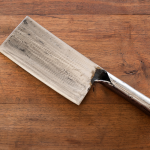img : https://www.hocho-knife.com/
Tamahagane is a type of traditional Japanese steel made with iron sand, mostly notably used to make knives, katanas, and other Japanese swords. Tamahagane steel offers a superior level of strength and durability compared to other steels, and was initially discovered in feudal Japan, when swordsmiths found out that iron sand allowed them to create stronger, higher quality steel which led to better quality swords. This discovery helped Japan become one of the world’s most dominant regions for swordmaking. The word Tamahagane is made of two Japanese words – “Tama” meaning round and precious, and “Hagane” meaning steel, therefore Tamahagane means a precious steel with a round shape.
Features of Tamahagane
Tamahagane is characterized by its high carbon content and is produced with iron sand, a type of sand with substantial concentrations of iron and is dark grey or blackish in color. The iron sand is key to what gives Tamahagane it’s unique characteristics, and there are two main types of iron sands which are found in Shimane, Japan. One type of iron sand is called, aome satetsu, a lower quality sand with less steel ore in its composition. The second type of iron is known as masa satetsu and is higher quality with more steel ore.
Tamahagane manufacturing process
The process to create Tamahagane steel begins by mixing together aome satetsu and masa satetsu by a person known as a murage. Next, the combined iron sand is placed into a tatara, a dried clay tub furnace that is heated to 1,000 degrees Celsius (1,800 degrees Fahrenheit) and typically measured four feet tall and four feet wide. The iron sands mix with the charcoal used to heat the furnace and is frequently turned over. Additional iron sand and charcoal is continuously added to improve the strength and hardness of the tamahagane. Since tamahagane is characterized by its high carbon content, the charcoal is important as it’s pure carbon. After mixing the iron sands and charcoal together for up to 72 hours, the clay tub is broken to release the tamahagane steel. The best steel is usually found on the edges of the furnace as this is where the oxidization process is strongest. This entire process is highly technical and is still used today in part to keep the tradition alive. The types of sand used or how much sand is used depended on the desired outcome of the steel.
Today, Tamahagane knives are famously manufactured by KATAOKA & Co. Ltd. In Niigata, Japan.
The blades are crafted with the highest level of care, and feature a VG5, high-carbon molybdenum vanadian steel core, enveloped by a layer of SUS410, 13-chrome stainless steel. The steels contain high amount of carbon and has a hardness of approximately 61 Rockwell. The edges of the blades are hand-finished and the beveled edges features angles between 14 and 15 degrees. They’re then finished with a mirror polish and a handle made from strongly-pressed plywood. KATAOKA strives to produce Tamahagane knives that are high quality, distinctive, beautiful, and highly functional. By listening to their customers and applying their feedback, KATAOKA is constantly improving their knives, resulting in blades that can be passed down through generations. Tamahagane knives are distinctive yet classic, high quality, extremely sharp, and durable enough for everyday use.
Summary
The long history of Tamahagane knives is well-known, and the traditional forging techniques have been passed on from feudal Japan to present day, meaning that by purchasing a Tamahagane knife today, you are still getting a high-quality traditional knife. If you are interested in purchasing a classic, high-quality knife for everyday use, there are four different series of Tamahagane knives from KATAOKA & Co. Ltd. Go ahead, grab one and enjoy your cooking!





